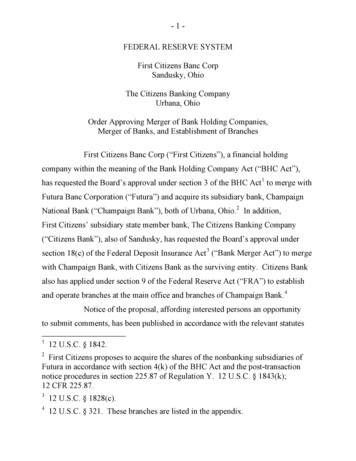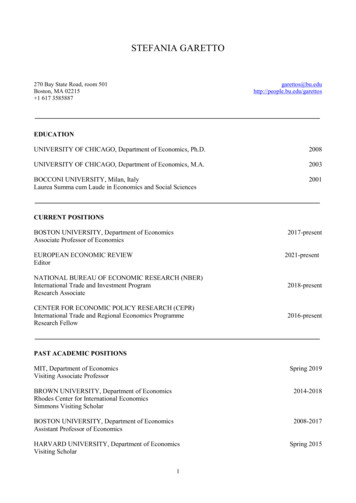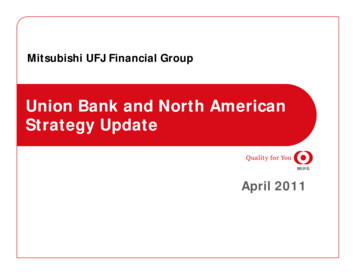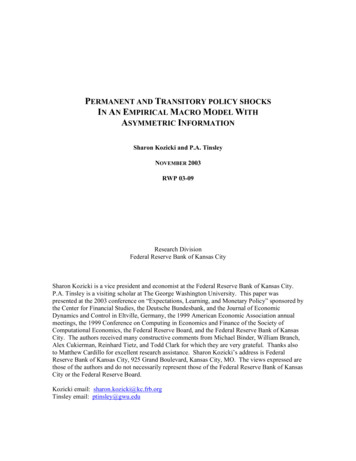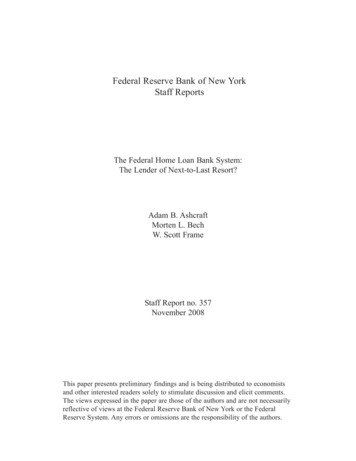
Transcription
Federal Reserve Bank of New YorkStaff ReportsThe Federal Home Loan Bank System:The Lender of Next-to-Last Resort?Adam B. AshcraftMorten L. BechW. Scott FrameStaff Report no. 357November 2008This paper presents preliminary findings and is being distributed to economistsand other interested readers solely to stimulate discussion and elicit comments.The views expressed in the paper are those of the authors and are not necessarilyreflective of views at the Federal Reserve Bank of New York or the FederalReserve System. Any errors or omissions are the responsibility of the authors.
The Federal Home Loan Bank System: The Lender of Next-to-Last Resort?Adam B. Ashcraft, Morten L. Bech, and W. Scott FrameFederal Reserve Bank of New York Staff Reports, no. 357November 2008JEL classification: E40, E59, G21, G28AbstractThe Federal Home Loan Bank (FHLB) System is a large, complex, and understudiedgovernment-sponsored liquidity facility that currently has more than 1 trillion in securedloans outstanding, mostly to commercial banks and thrifts. In this paper, we document thesignificant role played by the FHLB System at the onset of the ongoing financial crisesand then provide evidence on the uses of these funds by the System’s bank and thriftmembers. Next, we identify the trade-offs faced by member-borrowers when choosingbetween accessing the FHLB System or the Federal Reserve’s Discount Window duringthe crisis period. We conclude by describing the fragmented U.S. lender-of-last-resortframework and finding that additional clarity about the respective roles of the variousliquidity facilities would be helpful.Key words: Federal Home Loan Bank, government-sponsored enterprise, lender of lastresort, liquidityAshcraft: Federal Reserve Bank of New York (e-mail: adam.ashcraft@ny.frb.org). Bech: FederalReserve Bank of New York (e-mail: morten.bech@ny.frb.org). Frame: Federal Reserve Bank ofAtlanta (e-mail: scott.frame@atl.frb.org).The authors are thankful for the helpful commentsprovided by Larry Wall, Larry White, and seminar participants at the Banque de France and theFederal Reserve Banks of Atlanta, Boston, Dallas, New York, and Philadelphia. The authors alsothank Dennis Kuo for excellent research assistance. The views expressed in this paper are thoseof the authors and do not necessarily reflect the position of the Federal Reserve Bank of Atlanta,the Federal Reserve Bank of New York, or the Federal Reserve System.
Table of ContentsIntroduction. 1The Federal Home Loan Bank System . 6The Role of FHLB Advances during the 2007 Liquidity Crisis . 10Aggregate Balance Sheets . 13Regression Analysis. 16Crisis-Related Lending by the Federal Reserve and the FHLB System. 19August 2007: The initial shock. 20December 2007: The TAF and Swap Lines with Foreign Central Banks . 22March 2008: Single-tranche OMO, TSLF, and PDCF . 25July and September 2008: Concerns about Fannie Mae and Freddie Mac. 26The Balance Sheets of the FHLB System and the Federal Reserve . 27Conclusion . 28Appendix A: All-in Cost Measures. 30Tables . 32Figures. 40References. 45List of TablesTable 1: Federal Home Loan Bank Size and Membership by District as of 12/31/2007 . 32Table 2: Federal Home Loan Bank System Combined Balance Sheet as of 12/31/2007. 33Table 3: Largest Dollar Increases in Advances by FHLB Members: 2007:Q2 to 2007:Q4. 34Table 4: Aggregate Call and Thrift Reports . 35Table 5: Changes in the Correlation of FHLB Advances with Balance Sheet Items . 37Table 6: LIBOR Panel Banks and their Access to FHLB Advances and the Discount Window . 38Table 7: Primary Dealers . 39List of FiguresFigure 1: Federal Home Loan Bank Advances. 40Figure 2: Spread of Selected Funding Rates to 4 Week FHLB Discount Note. 40Figure 3: Liquidity provided by the Federal Reserve and Federal Home Loan Bank System . 41Figure 4: Liquidity provided by the Federal Reserve . 41Figure 5: The Fraction of Days Where Federal Funds Intraday High Exceeds Primary Credit Rate. 42i
Figure 6: Discount Window Borrowings and Spread in All-in Costs between the Federal Reserveand the Federal Home Loan Bank System. 42Figure 7: One Month LIBOR – Overnight Index Swaps Spread. 43Figure 8: Non-FHLB member less full member 1-Month Dollar LIBOR Bids, Dailyobservations, January 2007 to August 2008 . 43Figure 9: Primary Credit Rate, TAF Stop Out Rate and All-in Cost Spread bwt. TAF and FHLBAdvance . 44Figure 10: Federal Reserve Domestic Financial Assets . 44ii
IntroductionIn July 2007, the credit rating agencies (Standard & Poors, Moody’s, and Fitch) responded to therapid deterioration in the performance of recently originated subprime mortgages by taking ahistorical downgrade action on the entire sector of associated mortgage-backed securities (MBS).This downgrade had global implications.Many of the very largest U.S. and European financial institutions were directly exposedto the subprime mortgage market through loans to subprime originators, investments in thesenior tranches of subprime MBS, and retained tranches of collateralized debt obligations(CDOs); the latter of which was largely secured by the subordinate tranches of subprime MBS.These same institutions were also indirectly exposed through their sponsorship of structuredinvestment vehicles (SIVs) and asset-backed commercial paper conduits (ABCP conduits),which purchased subprime MBS, as well as through exposures to their trading counterpartieswho in turn had similar problems.The ratings action also triggered a loss of confidence by investors in a broad array ofstructured finance products. Related selling and hedging activity put additional downwardpressure on the prices of a broad range of structured finance securities.Mark-to-marketaccounting rules, in turn, resulted in the recognition of large accounting losses and a materialdeterioration in capital positions for the exposed institutions. Uncertainty about the ultimatelevel of exposure faced by individual institutions prompted money market investors to reducetheir exposure to any entity which might have exposure; thereby leading to a sharp increase inthe cost and a significant reduction in the availability of term funding. This stress in termfunding markets was key because the inability of institutions to access term credit -- concurrentwith the breakdown of the originate-to-distribute model of financial intermediation that left them1
with unexpected assets on their balance sheets -- would impair the ability of these institutions tooriginate new credit and amplify the effect of the correction in the housing and mortgagemarkets.Conventional wisdom holds that, when faced with such liquidity shocks, a governmentsponsored liquidity provider (e.g., the central bank) should be available to act as a lender of lastresort.1 Over the last year, the Federal Reserve has indeed played the role of a lender of lastresort and has provided substantial amounts of liquidity to the financial system. However, at theoutset of the liquidity crisis, the Federal Reserve saw little demand for primary credit through itsDiscount Window -- even after lowering the discount rate from 100 basis points to 50 basispoints above the Federal Funds target.2 Some observers attributed the lack of Discount Windowlending during this period to the notion of there being a ‘stigma’ to such borrowing insofar as itwould send an adverse signal about the financial viability of the borrower. However, the lack ofborrowing from the Discount Window can also be explained by the presence of an alternative,lower cost government-sponsored liquidity backstop: The Federal Home Loan Bank System(FHLB) System.The FHLB System is a large, complex, and understudied U.S. government-sponsoredenterprise (GSE) that was created in the midst of the Great Depression. This housing GSEconsists of 12 cooperatively owned wholesale banks that act as a general source of liquidity to1Frexias, Giannini, Haggarth, and Soussa (1999) define the role of the lender of last resort to be the discretionaryprovision of liquidity to in reaction to an adverse shock that causes an abnormal increase in the demand for liquiditynot available from an alternative source. While history provides some examples of the lenders of last resort beingprivate entities (e.g. clearing houses in the United States prior to the establishment of the Federal Reserve) or evenprivate individuals (J.P. Morgan in 1907), we consider the lender of last resort to be either part of the government oroperating with explicit or implicit governmental backing.2The Discount Window is historically the principal mechanism through which the Federal Reserve performs itslender of last resort function. The Discount Window is considered to be a “Lombard Facility” – meaning thateligible depository institutions can freely access central bank credit at a penalty rate with appropriate collateral. TheDiscount Window began operating this way in 2003.2
over 8,000 member financial institutions, which are commercial banks, thrifts, credit unions, andinsurance companies.This liquidity is primarily provided through “advances” or (over)collateralized lending to members. During the second half of 2007, the FHLB System increasedits advance lending by 235 billion to 875 billion by the end of that year (a 36.7% increase).And ten FHLB members alone accounted for almost 150 billion of this new advance lending.Advances have continued to grow into 2008, albeit at a slower rate, and stood at 914 billion asof June 30, 2008.Interestingly, the re-intermediation of credit through the FHLBs during the fall of 2007was quite different from what occurred during the last major global liquidity event: the Asianfinancial crisis. During the fall of 1998, money market investors ran from short-term paperissued by the corporate sector and deposited their funds with the banking system. Banks, in turn,re-lent those funds to corporations through backup lines of credit (e.g., Gatev, Schuermann andStrahan 2005). By contrast, during the recent liquidity stress, money market investors ran awayfrom debt issued or sponsored by depository institutions and into instruments guaranteedexplicitly or implicity by the U.S. Treasury. By issuing implicitly guaranteed debt, the FHLBSystem was able to re-intermediate term funding to member depository institutions throughadvances.However, it became clear in December 2007 (and again in March 2008) that the responseof the FHLB System was not enough to ease all of the stress in term funding markets.Institutions ineligible for FHLB membership, such as foreign banks and primary dealers,continued to have significant demands for term dollar funding and were not borrowing from theFederal Reserve. While operating using only the Discount Window and open market operations3
for most of it existence, necessity became the mother of invention, and the Federal Reserve hadintroduced no fewer than seven new liquidity facilities (as of August 31, 2008).3During the recent financial crisis, the liquidity facilities of the Federal Reserve and theFHLB System have at the same time complemented and competed with each other. The FHLBSystem took the early lead, and it was not until March 2008 that the Federal Reserve became thelargest government-sponsored liquidity facility in terms of crisis-related lending to the financialsystem. Hence, we view the FHLB system as the lender of next to last resort.The objective of our paper is three-fold. First, we seek to document and understand therole played by the FHLB System in the ongoing financial crisis. To this end, we provide a briefoverview of this larger sibling to the more well-known housing GSEs: Freddie Mac and FannieMae. We then document FHLB advance activity during the second half of 2007 and analyzehow these funds were used by commercial banks and thrifts.Second, we want to understand the interplay between the liquidity facilities provided bythe FHLB System and the Federal Reserve, respectively. We do so by comparing quantities andprices. As a general reluctance to lend among private agents emerged at the outset of the crisis,the FHLB System became an attractive source of funding as investors placed a premium on theimplicit government backing of their debt. Despite substantial cuts in the Federal Reserve’sdiscount rate relative to the federal funds target, the FHLB System continued to see strongdemand for advances through the end of 2007. However, following heightened concerns aboutthe financial health of Fannie Mae and Freddie Mac in the second quarter of 2008, the FHLBSystem found itself “guilty by association” and saw its borrowing costs and advance rates rise.3These new facilities are the: Term Discount Window (TDW), Term Auction Facility (TAF), swaps with theEuropean Central Bank and the Swiss National Bank, single-tranche open market operations (Single-TrancheOMOs), Term Security Lending Facility (TSLF), Primary Dealer Credit Facility (PDCF), and Term SecuritiesLending Facility Options Program (TOP).4
Hence, the Discount Window became a more attractive option in terms of pricing and saw someincrease in borrowings.Finally, we wish to draw insights and lessons from this episode in order to frame adiscussion for how to think about the lender of last resort role in a modernized financialregulatory structure. While the Federal Reserve has eclipsed the FHLB System in terms of totallending during the crisis, the FHLB System has been the largest lender to U.S. depositoryinstitutions. Indeed, much of the Federal Reserve’s liquidity operations have been for the benefitof non-depository or foreign financial institutions. Moreover, had U.S. depository institutionsturned to the Federal Reserve’s Discount Window instead of the FHLB System, the amount ofunencumbered outright holdings of U.S. Treasury securities on the Federal Reserve’s balancesheet would have been below 100 billion (as of August 31, 2008) assuming that all credit wouldhave been forthcoming and sterilized. Ultimately, it was concerns about the Federal Reserve’sability to further address financial market strains without affecting its monetary policy stancethat led to the Supplementary Financing Program (SPF) and the statutory authority to pay intereston reserves three years ahead of the original schedule.The organization of the paper closely follows these objectives.We begin with anoverview of the FHLB System, continue with an analysis of the uses of FHLB advances duringthe recent stress, and then provide a detailed comparison of the liquidity facilities of the FHLBSystem and the Federal Reserve.5
The Federal Home Loan Bank SystemThe FHLB System is composed of 12 regional Federal Home Loan Banks (FHLBs) andan Office of Finance that acts as the FHLBs’ gateway to the capital markets. Each FHLB is aseparate legal entity and has its own management, employees, board of directors, and financialstatements. FHLBs are cooperatively owned by its member commercial banks, thrifts, creditunions, and insurance companies headquartered within the distinct geographic area that theFHLB has been assigned to serve. Members must either maintain at least 10 percent of theirasset portfolios in mortgage-related assets or be designated as “community financialinstitutions.”4 The FHLB System was originally created in 1932 to primarily serve the thrift (orsavings and loan) industry, which at that time did not have access to the Federal Reserve’sDiscount Window.5,6 In 1989, following the savings and loan crisis, FHLB membership wasexpanded to include commercial banks and credit unions. As of year-end 2007, the FHLBSystem had 8,075 financial institution members – 87% of which were commercial banks orthrifts.Table 1 presents the relative sizes (in terms of total assets) and numbers of members foreach of the 12 FHLBs as of December 31, 2007. The FHLB of San Francisco is by far thelargest institution ( 323.0 billion), accounting for almost a quarter of the FHLB System's assets.The FHLBs of Des Moines and Atlanta each have 15% of the total FHLB System membership.By contrast, the table also shows the extent to which each bank's business is dominated by its4“Community financial institutions” are defined at 12 U.S.C. § 1422(13).In the Presidential statement about the signing of the Federal Home Loan Bank Act in 1932, Herbert Hoover notedthat: “Its purpose is to establish a series of discount banks for home mortgages, performing a function forhomeowners somewhat similar to that performed in the commercial field by the Federal Reserve banks through theirdiscount facilities.” See: http://www.presidency.ucsb.edu/ws/?pid 23176 .6The Depository Institutions Deregulation and Monetary Control Act of 1980 opened the Discount Window to allbanks, savings and loan associations, savings banks, and credit unions holding transactions accounts and nonpersonal time deposits.56
largest members. The percentage of each bank's advances (loans to members) that is accountedfor by its five largest users range from 42.1% (the FHLB of Chicago) to 79.0% (the FHLB ofSan Francisco).7The FHLB System is often viewed as a whole because virtually all FHLB financing takesthe form of consolidated obligations for which the 12 institutions are jointly and severally liable.Hence, Table 2 shows the consolidated balance sheet of the 12 FHLBs, as of December 31, 2007.Advances constitute 68.7% of the FHLB System's 1,274.5 billion in total assets; cash andinvestments another 23.4%; and holdings of residential mortgages are 7.2% of total assets. Onthe liability side of the balance sheet, consolidated obligations constitute 92.5% of total assets.The FHLB System's capital is only 4.2% of assets, and almost all of that is the members'contributed capital; retained earnings are only 0.3% of assets. The FHLB System is thus a verylarge and highly leveraged financial institution.The FHLB System is considered a government-sponsored enterprise (GSE) since it hasbeen expressly created by an Act of Congress (The Federal Home Loan Bank Act of 1932) thatincludes several institutional benefits designed to reduce their operating costs. In this way, theFHLB System is similar to the other two housing GSEs – Fannie Mae and Freddie Mac. Certaincharter provisions combined with past government actions, have created a perception in financialmarkets that GSE obligations are implicitly guaranteed by the federal government.8 This, inturn, allows these institutions to finance their activities by issuing debt on more favorable terms7Similarly, the percentage of each bank's capital that is accounted for by its five largest members ranges from 30.0%(the FHLB of Chicago) to 74.9% (the FHLB of San Francisco).8Special privileges accruing to the FHLB System include: a provision authorizing the Treasury Secretary to purchase upto 4 billion of FHLB securities; the treatment of FHLB securities as “government securities” under the Securities andExchange Act of 1934; the statutory ability to use the Federal Reserve as its fiscal agent (like the Treasury); and anexemption from the bankruptcy code by way of being considered “federal instrumentalities”.7
than any AAA-rated private corporation.9 Housing GSEs also accrue cost savings through anexemption from federal corporate income taxes and an exemption from Securities and ExchangeCommission registration requirements for their debt securities. Key differences between theFHLB System and Fannie Mae/Freddie Mac relate to their primary functions (collateralizedlending via advances versus issuing credit guarantees on mortgage-backed securities) andownership structure (cooperative versus publicly held corporations). The 1.3 trillion in totalassets controlled by the FHLB System as of June 30, 2008 exceeded those for Fannie Mae andFreddie Mac at that time ( 886 billion and 879 billion respectively).10It is understood that explicit or implicit government guarantees of financial institutionliabilities will distort the risk-taking incentives of the insured institutions in a way that increasesthe probability of financial distress.11 Recognizing this potential moral hazard, the federalgovernment regulates the FHLB System for “safety and soundness” through the Federal HousingFinance Agency (FHFA), which also has responsibility for Fannie Mae and Freddie Mac. TheFHFA is an independent agency within the executive branch that was created in July 2008 withthe passage of the Housing and Economic Recovery Act of 2008. Previously, the FederalHousing Finance Board had sole responsibility for supervising the FHLB System. Like otherfinancial regulators, the FHFA is authorized to set capital standards, conduct examinations, andtake certain enforcement actions if unsafe or unsound practices are identified.129See Ambrose and Warga (1996, 2002), Nothaft, Pearce, and Stevanovic (2002), and Passmore, Sherlund, and Burgess(2005).10Fannie Mae and Freddie Mac also maintain large volumes of credit guarantees on mortgage-backed securities.These guarantees (net of securities held on their own balance sheets) totaled 2.3 trillion (Fannie Mae) and 1.4trillion (Freddie Mac) as of June 30, 2008.11Flannery and Frame (2006) identify and analyze FHLB System risk-taking incentives and compare them to thosefaced by Fannie Mae and Freddie Mac.12The regulations currently applying to the FHLB System are those previously promulgated by the Federal HousingFinance Board. These regulations are codified at 12 C.F.R. § 900-999.8
The stated public purpose of the FHLB System is to provide their members with financialproducts and services, most notably advances, to assist and enhance the members’ financing ofhousing and community lending.13 One important empirical question relates to what types ofassets FHLB advances ultimately fund on member balance sheets. While members must postcollateral to secure their advances and that collateral is typically residential mortgage-related (wholeloans or mortgage-backed securities), money is fungible; there is no reason why the members wouldnecessarily use the borrowed funds for further housing loans or other designated uses. Indeed,empirical evidence provided by Frame, Hancock, and Passmore (2007) suggests that FHLBadvances are just as likely to fund other types of bank credit as to fund residential mortgages.Another important question relates to whether the benefits of FHLB membership flow tomembers and, if so, whether it flows further still to consumers – especially mortgage borrowers.In one study, the U.S. Congressional Budget Office (2004) estimated that the FHLB Systemaccrued 3.4 billion in implicit federal support in 2003 and that 0.2 billion of that accrued toconforming mortgage borrowers while the remainder was captured by various FHLBstakeholders. Presumably, most of these benefits accrue to the FHLBs member-owners who, inturn, pass them on to their customers. However, some benefits may be captured by FHLBmanagement and shareholders. A more comprehensive analysis of the distribution of FHLBbenefits would be a welcome addition to the literature.13See 12 U.S.C. § 1430(a)(2).9
The Role of FHLB Advances during the 2007 Liquidity CrisisAdvances are historically the primary activity conducted by the FHLBs. These loans aregenerally collateralized by residential mortgage-related assets (whole loans and mortgage-backedsecurities) and U.S. Treasury and Federal Agency securities.14 Beyond the explicit collateral anda member’s capital subscription, the FHLBs also have priority over the claims of depositors andalmost all other creditors (including the Federal Deposit Insurance Corporation, or FDIC) in theevent of a member’s default; this is often described as a “super-lien.”15 Taken together, thesefeatures help to explain why none of the FHLBs has ever suffered a loss on an advance.Unfortunately from a public policy perspective, the combination of over-collateralizationand the super-lien can create an incentive for the FHLBs to provide their members with morecredit than is socially optimal. This is due to the fact that these provisions reduce the FHLBs’incentives to screen and monitor their members and the pledged collateral. This arrangementalso serves to weaken the claims of existing private creditors and expose the FDIC to increasedlosses in the event of failure (Stojanovic, Vaughan and Yeager 2008). Consistent with thepotential for excessive lending, the FHFA (as previously established by the Federal HousingFinance Board) does not impose loan to one borrower limits on the FHLBs; and that individualFHLB internal limits (when imposed) are generally set in the range of 30 - 50 percent of membertotal assets. By contrast, national banks limit loans to one borrower at 25 percent of bank totalequity (with not more than 15 percent of bank equity being unsecured).16FHLB advances are generally viewed as an attractive source of wholesale funds.Advance interest rates are set by the individual FHLBs and reflect a mark-up to the cost of14See 12 U.S.C. § 1430(a)(3) for a complete list of eligible collateral. Federal Agency securities are generallysynonymous with debt and mortgage-backed securities issued by government sponsored enterprises.15See 12 U.S.C. § 1430(e).16See 12 U.S.C. § 84(a) as this applies to national banks.10
Federal Agency debt funding secured by the Office of Finance. However, in order to receive anadvance, a member must also purchase FHLB stock in an amount ranging from 2-6 percent ofthe advance (as dictated by the individual FHLB’s capital plan). While FHLB stock typicallypays a dividend, to the extent this pay-out falls below the members’ marginal investmentopportunity the stock purchase requirement can create an opportunity cost. Generally speaking,there is an inverse relationship between advance rates and dividend rates across FHLBs; withdifferences presumably reflecting efficiencies and the collective preferences of the membership.Advances grew rapidly during the 1990s and early 2000s following the introduction ofcommercial banks as FHLB System members. However, from the end of 2005 through the firsthalf of 2007, the level of outstanding FHLB advances oscillated within a narrow range of 620to 640 billion (see Figure 1). The amount of outstanding advances ticked up slightly in July2007, but then exploded during August and September -- moving from 659 to 824 billion (a25% increase). FHLB advances stood at 875 billion at the end of 2007 – an amount equivalentto 6.2% of U.S. gross domestic product.During the second half of 2007, the ten most active members accounted for almost 150billion of the 235 billion increase (63%). Table 3 shows that Washington Mutual, Bank ofAmerica, and Countrywide borrowed the largest amounts from the FHLB System during thisperiod; and for Washington Mutual and Countrywide their ratios of advances-to-total assets roseto 20 and 40 percent, respectively.As liquidity pressures developed during the fall of 2007, FHLB advances became anattractive source of funding in terms of pricing. During this time, investors sought the protectionof (explicitly or implicitly) federally guaranteed obligations and FHLB funding costs declinedrelative to other benchmarks like LIBOR and AA-rated asset-backed commercial paper. Forexample, the average spread between one month LIBOR and four week FHLB discount notes11
increased from about 16 basis points prior to the turmoil to 44 basis points during the following12 months. By contrast, the average spread between a 30-day advance from the FHLB New Yorkand four week FHLB System discount notes has remained unchanged at about 25 basis points(see Figure 2).Much of the growth in FHLB advances in the second half of 2007 reflected
The Federal Home Loan Bank System: The Lender of Next-to-Last Resort? Adam B. Ashcraft, Morten L. Bech, and W. Scott Frame Federal Reserve Bank of New York Staff Reports, no. 357 November 2008 JEL classification: E40, E59, G21, G28 Abstract The Federal Home Loan Bank (FHLB) System is a large, complex, and understudied




